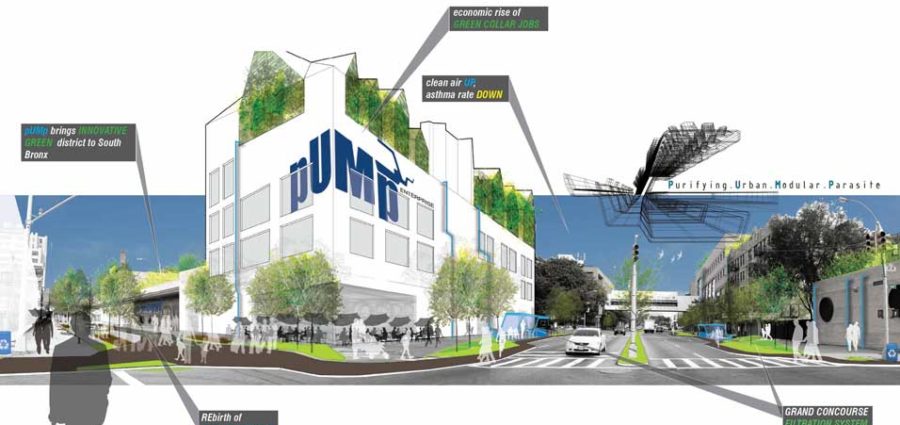Seven compelling visions for the future of the Grand Concourse are on view at The Bronx Museum of Arts in Intersections: The Grand Concourse Beyond 100 from November 1, 2009 through January 4, 2010.
Green footbridges traverse the Concourse’s “art deco cliffs”; windmills generate energy while creating new public spaces; farm plots weave in and out of playgrounds and public plazas; and a boulevard-long audio-visual nervous system connects people along the Concourse with each other and the world: these are among the compelling concepts for a 21st century New York City that edged out nearly 200 other proposals to make it to the penultimate round of an international an ideas competition co-organized and presented by The Bronx Museum of the Arts and Design Trust for Public Space.
“These bold new visions may look like science fiction—but in fact they are glimpses of the urban future, based upon the existing character of the Grand Concourse—and are feasible given evolving technology and urban planning,” says Holly Block, director, The Bronx Museum of the Arts. “Altogether, they suggest that the Grand Concourse has the potential to become the city’s most adventurous and livable urban experiment.”
Hundreds of leading and emerging architects and designers and city planners from more than 25 countries heeded the open call for the competition. From this pool the finalists are Christina Belton, Taewook Cha, Brenda Curtis, Lia Kelerchian, Gentry Lock, Erika Matthias and Shachi Pandey of EDAW, New York, NY; Vincent Lavergne, Jeremy Nadau, Mathieu Lavergne, and Remi Mendes, Nadau Lavergne Architects, Antony, France; Jason Austin and Aleksandr Mergold, Philadelphia, PA; Dongsei Kim and Jamieson Fajardo, Columbia University, New York, NY; Christopher Ryan, Harvard University, Cambridge, MA; Emily Osgood, Alejandra Diaz, Laura Keller, Megan Gibbons, and Lisa Woodley, MISI Company and Itir Sonuparlak, Columbia University, New York, NY; and Angus McCullough, Brooklyn, NY. From this roster, one winner will be announced in early November in tandem with the November 1st opening of the exhibition of models, renderings, drawings, and writings describing the finalists’ concepts.
“In reviewing the proposals, we observed a generational shift. Today, emerging architects and city planners see the Bronx as an alluring destination for culture and fertile ground for design innovation—not as a broken place in need of repair,” says Deborah Marton, executive director, Design Trust for Public Space.
“This competition comes at an extraordinarily opportune time. While good work has been done in recent years in the Bronx, by both city agencies and the private sector, a clear plan for the borough as a whole and the Concourse specifically has yet to emerge,” says Marton.
Finalist Projects
Altogether, the pervasive assessment running through the seven finalists proposals, and many of the original entries, is that the Grand Concourse should be transformed from a thoroughfare for cars into a dynamic new public space for people with separate strands for transportation modes and activities. The concepts selected as finalists are:
Agricultural Urbanism
New York, NY
Dozens of farm plots, gardens, and farm stands are introduced into the Concourse, and interwoven with playgrounds, public plazas, performance spaces, and a signature glass conservatory by the seven-person team from EDAW/AECOM, a design and planning firm in New York City. They capitalize on the many ways in which agriculture can activate public spaces, introducing multi-use bike paths, sidewalks, and a tram with connections to existing transit, and a system to capture, filter, and re-use rainwater.
From Speedway to Mainstreet
Antony, France
Nadau Lavergne Architects, a firm based in Antony, France, reclaims the Concourse’s symbolic and physical connections to Central Park, as well as the north-south axis from Manhattan to the Bronx. They open up an entirely new public space by creating green spaces on the roofs of existing apartments and buildings along the thoroughfare and connecting them via aerial pathways. They also re-vegetate the Grand Concourse, and introduce streetcars for pleasure and for cleaner transportation.
The Grand Resource
Philadelphia, PA
Taking their inspiration from New York’s official City Seal, which features the sails of Dutch windmills, Jason Austin and Aleksandr Mergold of the Philadelphia-based design firm Austin+Mergold, LLC, propose a series of open-structure towers supporting wind turbines all along the Grand Concourse. These structures, which also support elevated cafes, gardens, and observation decks, would be a new kind of civic monument—a series of Eiffel Towers for the 21st century, which would become signature landmarks for the Bronx, but also serve as a vital part of the urban infrastructure.
Live Wired
Brooklyn, NY
Inspired by graffiti artists, Angus McCullough of Brooklyn, NY envisions a system whereby the residents along the Grand Concourse share information with each other and create content along the corridor in playful, surprising ways. By placing speakers, microphones, projectors, and cameras in everyday public spaces—from bodegas to bus stops to Yankee games—he foresees a time when messages are conveyed via transitory nodes, projections enliven subway platforms like public art, and videos on the mega-tron at Yankee Stadium make the outside world a part of the game and vice versa.
PUMP (Purifying Urban Modular Parasite)
New York, NY
The PUMP, a sleek ribbon-like device about as wide as a lane of traffic, would be installed along the Major Deegan Expressway if Dongsei Kim and his collaborator Jamieson Fajardo have their way. Kim and Fajardo, both students at Columbia Unviersity, see the PUMP as a way to clean air, provide acoustic buffering, filtrate rainwater, and ultimately provide pedestrian access to a new green waterfront. By manufacturing this new kind air purification technology in the industrial district adjacent to the Lower Concourse, PUMP would spur development of green industries in neighborhoods along the Grand Concourse.
Point by Point Development for the Grand Concourse
Cambridge, MA
Christopher Ryan, a student at Harvard University, has devised a scheme that could serve as a toolkit for inserting new public activities, facilities, and transportation modes along the Concourse. He proposes adding new hubs of activity to the center strip of the Grand Concourse point by point, filling in gaps over time based on needs articulated by different neighborhood groups. These elements could range from soccer fields, skateboard ramps, and handball courts to bench seating and open-air markets.
Revisioning the Bronx
New York, NY
The six-person team from MISI Company crafted an experience design approach to guide future changes on the Concourse. Rather than focus on specific interventions, the team proposes a method for reaching out to a broad spectrum of local residents and other stakeholders and documenting their desires for their neighborhoods. Their findings would create a layered portrait of the neighborhoods along the Grand Concourse, and could inform the schemes from the other design firms participating in the competition.








